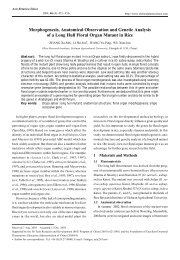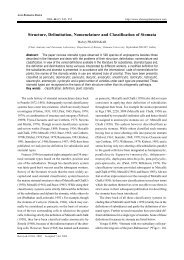Abiotic and biotic stresses and changes in the lignin ... - ResearchGate
Abiotic and biotic stresses and changes in the lignin ... - ResearchGate
Abiotic and biotic stresses and changes in the lignin ... - ResearchGate
You also want an ePaper? Increase the reach of your titles
YUMPU automatically turns print PDFs into web optimized ePapers that Google loves.
8<br />
149<br />
150<br />
151<br />
152<br />
153<br />
154<br />
155<br />
156<br />
157<br />
158<br />
159<br />
160<br />
161<br />
162<br />
163<br />
164<br />
165<br />
166<br />
167<br />
168<br />
169<br />
170<br />
171<br />
172<br />
173<br />
Very little is known about <strong>the</strong> effects of drought on lign<strong>in</strong> biosyn<strong>the</strong>sis. A<br />
reduction <strong>in</strong> <strong>the</strong> amount of ferulic acid <strong>and</strong> an <strong>in</strong>crease of p-coumaric <strong>and</strong> caffeic acids<br />
<strong>in</strong> <strong>the</strong> xylem sap of maize was observed after 12 days of water uphold<strong>in</strong>g (Alvarez et al.,<br />
2008). It was also detected decreased anionic peroxidase activity <strong>and</strong> <strong>in</strong>creased cationic<br />
peroxidase activity. Accord<strong>in</strong>g to <strong>the</strong> authors, <strong>the</strong> <strong>in</strong>crease of free lign<strong>in</strong> precursors <strong>in</strong><br />
<strong>the</strong> xylem sap as well as <strong>the</strong> reduced anionic peroxidase activity could be an <strong>in</strong>dication<br />
that drought decreases <strong>the</strong> biosyn<strong>the</strong>sis of lign<strong>in</strong> <strong>in</strong> maize (Alvarez et al., 2008).<br />
Different regions of <strong>the</strong> maize root may respond differently to drought, as <strong>the</strong><br />
deposition of lign<strong>in</strong> may be greater <strong>in</strong> a specific region of <strong>the</strong> root or at certa<strong>in</strong> times of<br />
stress (Fan et al., 2006; Yang et al., 2006; Yoshimura et al., 2008).<br />
It has been shown that <strong>the</strong> basal part of <strong>the</strong> roots of maize plants under water<br />
stress exhibit a greater reduction <strong>in</strong> growth than <strong>the</strong> apical region (Fan et al., 2006).<br />
Such a reduction was associated with an <strong>in</strong>creased expression of two genes <strong>in</strong>volved <strong>in</strong><br />
<strong>the</strong> biosyn<strong>the</strong>sis of lign<strong>in</strong>: c<strong>in</strong>namoyl-CoA reductase 1 <strong>and</strong> 2. The reduction was also<br />
associated with <strong>in</strong>creased deposition of lign<strong>in</strong>, which stiffened cell wall extensibility<br />
<strong>and</strong> decreased cell wall expansion. In <strong>the</strong>se plants, reduced growth of <strong>the</strong> basal root<br />
might improve <strong>the</strong> availability of water, m<strong>in</strong>erals <strong>and</strong> sugars, factors necessary to<br />
ma<strong>in</strong>ta<strong>in</strong> m<strong>in</strong>imum growth <strong>and</strong> survival of young cells <strong>in</strong> <strong>the</strong> most apical portion,<br />
facilitat<strong>in</strong>g renewed growth after rehydration (Fan et al., 2006).<br />
Researches have shown an <strong>in</strong>crease <strong>in</strong> <strong>the</strong> expression of genes related to cell<br />
growth <strong>and</strong> extensibility <strong>in</strong> <strong>the</strong> roots of rice (Oryza sativa L.) plants dur<strong>in</strong>g <strong>the</strong> <strong>in</strong>itial<br />
stages (16 hours) of water stress, enabl<strong>in</strong>g root growth <strong>in</strong> <strong>the</strong>se plants (Yang et al.,<br />
2006). It was also observed that <strong>the</strong>re was an <strong>in</strong>creased expression of genes <strong>in</strong>volved <strong>in</strong><br />
lign<strong>in</strong> biosyn<strong>the</strong>sis dur<strong>in</strong>g <strong>the</strong> <strong>in</strong>termediate <strong>and</strong> f<strong>in</strong>al stages of water stress (from 48 to<br />
72 hours), such as those cod<strong>in</strong>g for PAL, C3H, 4CL, CCoAOMT, CAD <strong>and</strong> peroxidase.







